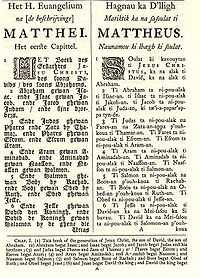Sinckan Manuscripts

The Sinckan Manuscripts (Chinese: 新港文書; pinyin: Xīngǎng wénshū; Wade–Giles: Hsin-kang wen-shu; also spelled Sinkang or Sinkan) refers to a series of leases, mortgages, and other commerce contracts written in the Sinckan language; they are commonly referred to as the "fanzi contracts." Some are written only in a romanized script, while others were bilingual with adjacent Han writing. Currently there are approximately 140 extant documents written in Sinckan; they are important in the study of Siraya culture and Taiwanese history in general although there are only a few scholars who can understand them.
History and background

The Sinckan language was spoken by the Siraya tribe that lived in what is now Tainan. During the time when Taiwan was under the administration of the Dutch East India Company, Dutch missionaries learned Sinckan to facilitate both missionary work and government affairs. They also created a romanized script and compiled a dictionary of the language, teaching the natives how to write their own language.
In 1625, Maarten Sonck, the Dutch governor of Taiwan, requested that the Netherlands send two to three missionaries to Taiwan for the purpose of converting the natives. However, the first group to arrive were visiting missionaries who did not have the authority to perform baptism rites. It was not until June 1627 that the first real minister, Rev. Georgius Candidius, arrived, upon which missionary work in Taiwan began in earnest. The first area to be targeted, the Sinckan settlement, had many converts by 1630.
In 1636, the Dutch started a school for the Sinckan that not only featured religious instruction, but also provided schooling in Western literature. Because the Dutch advocated missionary work to be done in the native language, the school was taught in the Sinckan language. The missionary Robertus Junius recorded in his 1643 education report that the Sinckan school had enrolled 80 students, of which 24 were learning to write and 8 to 10 had solid penmanship, while in neighboring Baccaluan school there were 90 students, of which 8 knew how to write.
Aside from proselytizing, the missionaries also compiled dictionaries and books of religious doctrine; they translated the Gospel of Matthew into Sinckan and also compiled a vocabulary of Favorlang, another aboriginal language. These would become important sources for later research. The most important Sinckan documents were the contracts between the Sinckan and the Han settlers, commonly known as the Fanzi contracts.
Although the Dutch only governed Taiwan for 38 years, they greatly influenced the development of indigenous culture. To take the Sinckan Manuscripts as an example, the latest extant documents in the Sinckan script date back to 1813, more than 150 years after the Dutch left Taiwan in 1662.
Origins
Shortly after the founding of Taihoku Imperial University in 1928, one of the scholars in the linguistics department, Naoyoshi Ogawa (小川尚義), gathered together a number of old texts in Tainan. In 1931, Naojiro Murakami (村上直次郎) edited and published them under the title The Sinckan Manuscripts. The compilation contained 109 "fanzi contracts," of which 87 were from the Sinckan settlement; 21 of those were bilingual in Han characters and Sinckan.